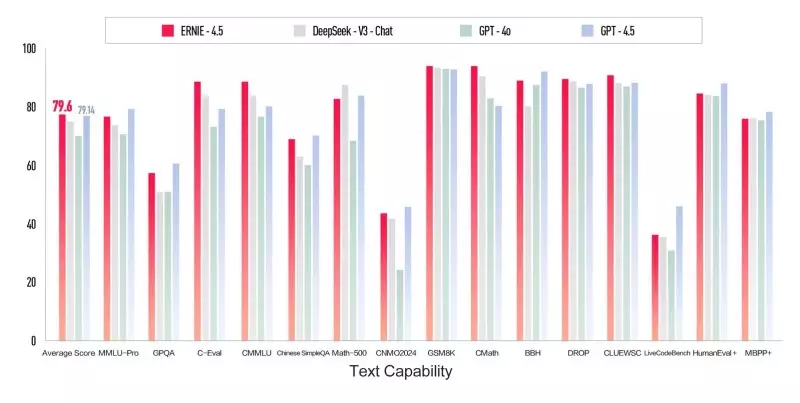The AI landscape is witnessing seismic shifts with the recent debut of Baidu’s ERNIE models—ERNIE 4.5 and ERNIE X1. These new technologies are rising to the surface as formidable competitors, boasting remarkable capabilities and cost efficiency. As artificial intelligence moves towards a future defined by multimodal understanding and advanced reasoning, Baidu seems to be strategically positioning itself as a key player in this dynamic environment. Let’s delve deeply into what these advancements mean for the tech industry and the potential ramifications for businesses worldwide.
A Bold Claim: ERNIE 4.5 and ERNIE X1 Exceeding Expectations
Baidu has entered the arena with models that they assert outperform major competitors like OpenAI’s GPT-4.5 and DeepSeek’s R1 reasoning model in various benchmarks. The audacity of claiming superiority over such established entities invites scrutiny but also invigorates the AI community with competitive spirit. With ERNIE 4.5 priced at a remarkable 99% less than GPT-4.5, the economic implications are noteworthy; organizations seeking innovative solutions can potentially revitalize their operations without the hefty costs typically associated with leading-edge technology.
While the performance benchmarks suggest significant advancements in language understanding and interactive capabilities, such as handling texts, images, and audio, it’s vital to contextualize what “state-of-the-art” truly entails. Benchmark tests such as CMMLU and GSM8K evaluate performance across multiple subjects and math problems, respectively. Thus, while Baidu exudes confidence in its innovation, enterprises must dig deeper to comprehend how the new technologies apply to their unique requirements or to the very tasks these models aim to facilitate.
Multi-Faceted Functionality Meets Cost-Effectiveness
ERNIE 4.5 and ERNIE X1 are not merely about numbers—they embody a strategic approach to flexibility. The bimodal function of ERNIE 4.5 enables it to accommodate various inputs, which could appeal to sectors such as customer service, creative writing, and potentially any field requiring linguistic interaction. The promising data indicates advancements in logical reasoning and reduced hallucination rates, making these models more dependable while generating responses.
Nevertheless, the reported limitations need highlighting. A critical gap is the relatively low token capacity of 8,000 compared to the staggering 128,000 available to its counterparts. This disparity raises questions about scalability and long-term application viability. As noted by industry observers, such a constrained context window may limit ERNIE’s usability in complex problem-solving scenarios, potentially confining its implementation primarily to straightforward tasks.
Strategically Integrated Solutions for Enterprises
For CIOs, CTOs, and other decision-makers, the launch of these models holds considerable weight. The integration of ERNIE into Baidu’s existing ecosystem—including Baidu Search and their chat interface—presents invaluable opportunities for enterprises looking to enhance their AI capabilities. However, the dichotomy between impressive performance metrics and the nuances of real-world applicability necessitates that organizations remain judicious in their evaluations.
Moreover, a pivotal focus should include evaluating the implications of localized AI solutions. Baidu’s emphasis on Chinese-language processing and regional knowledge could enable more effective applications in China and among Chinese-speaking populations. This localization factor may render Baidu’s solutions significantly more advantageous when applied within respective cultural and operational contexts compared to Western models.
Future Implications: The Road Ahead for Baidu
Artificial intelligence is on a rapid trajectory toward sophistication, and companies like Baidu are steering that ship toward uncharted territories. Their investment in foundational technologies, data centers, and infrastructure illustrates a commitment to developing next-generation AI tools that can cater to a variety of user demands. By strategically positioning themselves at the intersection of advanced reasoning and multimodal capabilities, Baidu aims not simply to compete but to lead in the evolving market landscape.
While financial considerations remain a cumulative factor, potential users must weigh the comprehensive feasibility of integrating AI technologies into their workflows. As we progress toward the midpoint of 2025, the anticipated open-source release and the forthcoming developments of ERNIE X1 promise to maintain the dialogue about accessibility and innovation in AI.
As the narrative around these models continues to evolve, it is crucial for businesses to balance the allure of cost-effectiveness against performance realities. Engagement with these emergent technologies comes with potential rewards but also demands a meticulous strategy. The shifts heralded by Baidu’s advances emphasize that in the complex theater of artificial intelligence, the true measure of success will hinge on both capability and strategic fit within the enterprise ecosystem.

